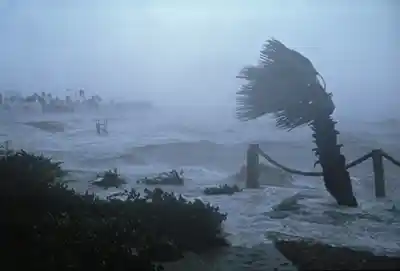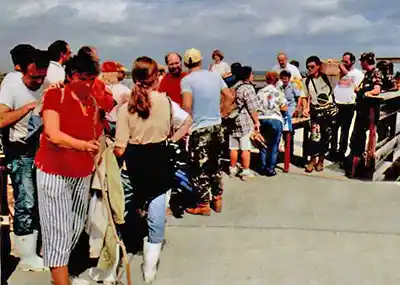
It’s that time of year again. Hurricane season. It’s also the anniversary of what many folks in the Lowcountry consider a day that will live in infamy: September 21, 1989. If you were living anywhere near here at the time, you know exactly what that date signifies.

“Where were you during Hugo?” are words that many long-time residents still ask one another. I personally recalled that, beforehand, I thought it was much ado about nothing. Standing in line at K-Mart waiting to buy a bedspread, I saw other customers stocking up on batteries, flashlights and the like. I thought, These folks clearly are not from here. We’ve seen enough hurricanes to know that there will be a day or two of no power and a few tree limbs down in the yard – minor inconveniences – but nothing to become alarmed about. Boy, was I wrong!

Pictorial books, videos and countless news articles have captured the terror, trauma and devastation that “the storm” brought to the Lowcountry. The eye of the Category 4 hurricane targeted Breach Inlet, but as any armchair meteorologist can tell you (and numerous local residents have since had the misfortune of becoming one), the area to the northeast of the eye gets the worst of it. That meant northern Mount Pleasant, Awendaw and McClellanville were sitting ducks. As bad as things were for the more populated areas south and west of the eye, including the cities of Charleston, North Charleston and Summerville, the damage east of the Cooper was utterly unimaginable.
Before Hugo, flood zone maps hadn’t been updated in decades, so countless homeowners were unaware they were sitting in harm’s way. The maps have since been revised and broader swaths of the area are now considered flood zones. Even so, folks who have no mortgage on their homes can opt out of purchasing flood insurance. Such was the case for many when Hugo arrived and they were left with no coverage to repair or rebuild their homes.

Particularly affected were residents in rural areas as well as some long-time island homeowners whose modest beach houses were washed out to sea. Having lost nearly everything and lacking an insurance safety net, some people were left with no recourse but to sell the empty lots where their houses once stood and move inland – putting the past, along with their memories and belongings, behind them.
And then there were the renters. Diane Owens and her family were living on Sullivan’s Island, near Breach Inlet, at the time. “We had renter’s insurance but that didn’t cover flood damage – and there was a 6-foot tidal surge in our apartment,” Owens explained. “I ended up getting $2,000 from my insurance company, but that didn’t cover our losses. It gave us enough to get a meager start, but we had nothing.”

In the aftermath, a lot of the storm’s victims looked to the federal government for assistance. But due to the “red tape” and massive number of applicants who needed aid, it was slow in coming. So, local churches and organizations such as East Cooper Community Outreach stepped up to fill the void or provide immediate assistance.
And for those who did have the financial means to make repairs, it wasn’t easy to find someone to do the work, as local contractors were swamped with job requests. Some contractors from around the country relocated to the tri-county area to fill the demand. But there were also grifters who came purportedly to assist, but instead took advantage of the situation. Many desperate homeowners paid unlicensed or unscrupulous contractors who took money yet didn’t complete – or sometimes even begin – the work. Newspapers and radio reports warned the public of such scams, but by then, it was often too late.
Emotionally overwhelmed, tri-county residents also had to contend for weeks with

driving on busy highways with no functioning traffic lights due to upended utility poles and power outages. That also meant most residents had no power – or air conditioning – for weeks or even months. Daily chores included boiling drinking water on outdoor grills or standing in long lines waiting for a delivery of bottled water to finally arrive at National Guard and Red Cross distribution sites. Cooking on cans of Sterno or charcoal grills, searching for a gas station that was open and actually had electricity to pump gas and finding a grocery store that might be operational because it had a generator were additional challenges. And even then, there was no guarantee there would be any food or supplies left on grocery store shelves. Relying on the newspaper and battery-operated radios, the public hung on every word for the latest updates on when and where help was available. Weeks turned into months for many residents.
What had initially seemed like it might be a “minor inconvenience” to some and, for others, maybe even the thrill of meeting Mother Nature face-to-face, quickly turned to stress and anxiety when reality set in.

But some had realized in advance what was in store. Hugo had shown its might a week earlier when it hit several Caribbean islands on its journey to our coast. Local authorities pleaded with Lowcountry residents to evacuate or seek higher ground. And to residents who had weathered hurricanes in the past, they emphasized that this was no ordinary visitor. Charleston’s former mayor Joe Riley had warned, “We are staring this killer hurricane right in the eye.”
While it’s true that lesser hurricanes have hit or swiped our area in the 34 years since it made landfall here, anyone who lived through Hugo and its aftermath won’t ever take any hurricane warning for granted. Owens has evacuated every time since then whenever authorities urge doing so and added, “Every single person I’ve talked to who stayed during Hugo has said, ‘Never again!’”

Isle of Palms Mayor Phillip Pounds urged “the importance of adhering to evacuation orders as well as maintaining an emergency kit with at least a three-days’ supply of essentials.” He also suggested that island residents refer to the city’s website for important emergency preparedness information.
Mount Pleasant’s Mayor Will Haynie emphasized that “there is no downside to over preparing” for a hurricane and added that if everyone follows official advisories to stay safe, it will also ensure that first responders can do their jobs safely.
Even once a hurricane has passed, the physical, emotional and economic toll on Lowcountry residents can linger for an extended period, as was the case with Hugo. Although their stories may now be relegated to history, the horror of that hurricane and its aftermath are forever etched in the memories of those who experienced the storm of the century.
Read the Hurricane Hugo Magazine Online
By Mary Coy

Leave a Reply